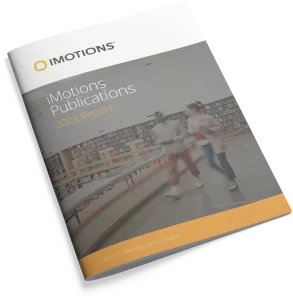-
A Framework towards Quantifying Human Restorativeness in Virtual Built Environments
Abstract: The impact of built environment on the human restorativeness has long been argued; however, the interrelations between neuroscience and the built environment, and the degree to which the built environment contributes to increased human restorativeness has not been completely understood yet. Understanding the interrelations between neuroscience and the built environment is critical as 90% […] -
Wavelet Phase Coherence Estimation of EEG Signals for Neuromarketing Studies
Abstract: This paper presents an Electroencephalography (EEG), Pulse Plethysmography (PPG) and Galvanic Skin Response (GSR) study for neuromarketing studies, which are related to analysis of relationship between electrodes and emotional stress across to commercial advertisement. Neuromarketing is a field of study with respect the application of neuroscience methods to analyze consumer behavior related to markets. Wavelet […] -
The Forensic biometric analysis of changes in facial response provoked by emotional arousal during initial and subsequent exposure to stimuli
Abstract: The purpose of this research is to determine if recall of the same stimuli produces similar emotional reactions as the initial response. Humans experience involuntary and voluntary responses when encountered with a stimulus. Facial expressions are the natural way to deduce and interpret the emotional state of that person. Specialized software called iMotions biometric […] -
US consumer reactions to China Shuanghui acquisition of Smithfield Foods and its neural basis
Abstract: The $4.7 billion acquisition of Smithfield Foods by China’s Shuanghui International (now WH Group) marks the largest Chinese takeover of a US company in history. Using electroencephalography along with an incentive compatible willingness‐to‐pay (WTP) elicitation mechanism, our study provides neural based evidence that the Shuanghui–Smithfield acquisition lowered consumers’ preference for the Smithfield brand, but […] -
Using both emotional responses and sensory attribute intensities to predict consumer liking and preference toward vegetable juice products
Abstract: Our previous research found that a combination of sensory attribute intensity and emotional responses helps in achieving better understanding of consumer acceptance and preference for basic taste solutions. By applying this finding to beverage samples, this study aimed to develop an optimum model of predicting either overall liking or preference of vegetable juice products […] -
Effects of familiarization on odor hedonic responses and food choices in children with autism spectrum disorders
Abstract: This study assessed whether olfactory familiarization can render food odors more pleasant, and consequently food more attractive, to children with autism spectrum disorder. Participants were first presented with a series of food odors (session 1). Then, they were familiarized on four occasions (time window: 5 weeks) with one of the two most neutral odors (the […] -
A Classification Model for Sensing Human Trust in Machines Using EEG and GSR
Abstract: Today, intelligent machines interact and collaborate with humans in a way that demands a greater level of trust between human and machine. A first step towards building intelligent machines that are capable of building and maintaining trust with humans is the design of a sensor that will enable machines to estimate human trust level […] -
The effect of social jet lag in women undergraduates’ visual attention within an e-learning environment: an eye tracking study
(Publication in Spanish) E-learning environments require students to adapt their eye gaze pattern to navigate the website and to follow instructions in order to do a task or take an exam. On the other hand, social jet lag has been related to concentration and attention problems in young, especially among women. To determine the effect […] -
A Preliminary Investigation towards the Development of an Emotion-Aware Partner Agent for Training Control
Abstract: Simulator-based training platforms have become increasingly popular on the grounds of their potential to facilitate skill acquisition within safe and controlled environments. However, current technology is limited in its ability to adapt to individual trainees. Tailoring is in fact typically based on recorded simulation inputs and outputs, or relies on costly and time-consuming trainer-driven […] -
The impact of seasonal colour change in planting on patients with psychotic disorders using biosensors
Abstract: The beneficial effect of nature on patients with mental disorders is of particular importance. There has been an increase in mental illnesses in recent years, but research on the design of healing gardens for mental and behavioural disorders remains limited. This paper is part of a wider study that aims to investigate the effect […]
Research Report 2024
In-depth look at the scientific landscape as powered by iMotions software, showcasing groundbreaking research and the impact of our tools in various scientific and industrial fields.

iMotions Science Resources
Looking for white papers, validation reports or research show casing iMotions Multimodal capabilities?
Share Your Research

850+ universities worldwide with an iMotions human behavior lab
73 of the top 100 highest ranked universities
710+ published research papers using iMotions
iMotions is used for some of the most interesting human behavior research studies carried out by top researchers around the world. Contact us to have your publication featured here.
The authors of these publications have used iMotions as a software tool within their research.
“Software should be cited on the same basis as any other research product such as a paper or a book; that is, authors should cite the appropriate set of software products just as they cite the appropriate set of papers” (Katz et al., 2020).
We therefore encourage you to cite the use of iMotions where appropriate.
How to cite iMotions
APA
iMotions (10), iMotions A/S, Copenhagen, Denmark, (2024).
Note: adjust the version and year where relevant.
5 Most Popular Blogs
Publications
Read publications made possible with iMotions
Blog
Get inspired and learn more from our expert content writers
Newsletter
A monthly close up of latest product and research news


